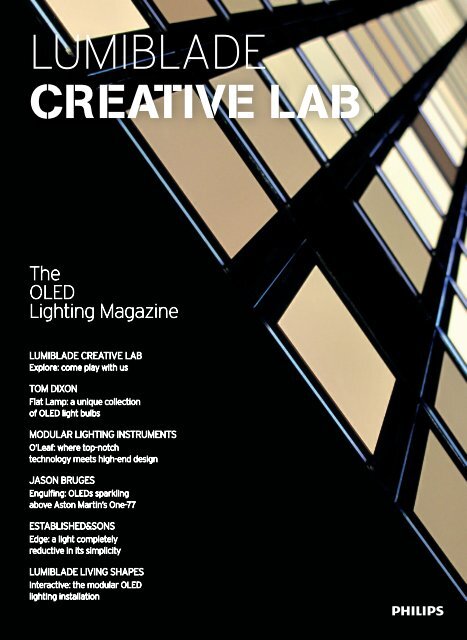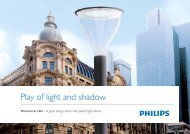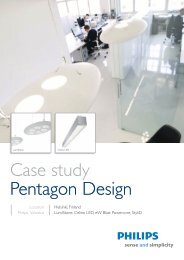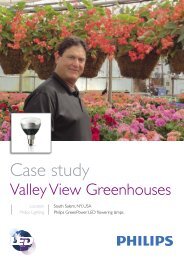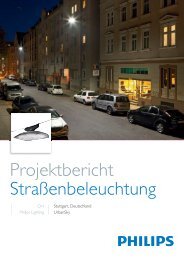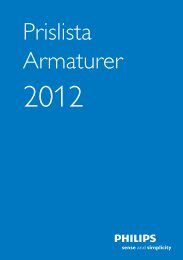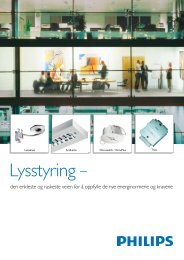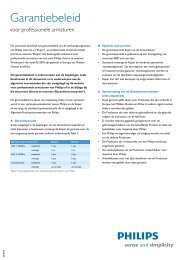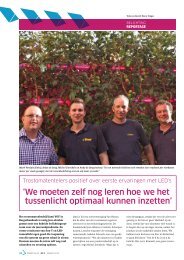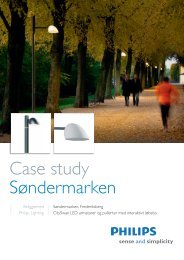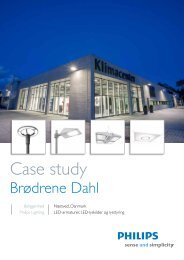LUMIBLADE CREATIVE LAB - Philips
LUMIBLADE CREATIVE LAB - Philips
LUMIBLADE CREATIVE LAB - Philips
Create successful ePaper yourself
Turn your PDF publications into a flip-book with our unique Google optimized e-Paper software.
<strong>LUMIBLADE</strong><br />
<strong>CREATIVE</strong> <strong>LAB</strong><br />
The<br />
OLED<br />
Lighting Magazine<br />
<strong>LUMIBLADE</strong> <strong>CREATIVE</strong> <strong>LAB</strong><br />
Explore: come play with us<br />
TOM DIXON<br />
Flat Lamp: a unique collection<br />
of OLED light bulbs<br />
MODULAR LIGHTING INSTRUMENTS<br />
O‘Leaf: where top-notch<br />
technology meets high-end design<br />
JASON BRUGES<br />
Engulfing: OLEDs sparkling<br />
above Aston Martin’s One-77<br />
ESTABLISHED&SONS<br />
Edge: a light completely<br />
reductive in its simplicity<br />
<strong>LUMIBLADE</strong> LIVING SHAPES<br />
Interactive: the modular OLED<br />
lighting installation
02<br />
Dear Reader,<br />
Welcome to the OLED Lighting Magazine! Within the <strong>Philips</strong> Lumiblade Creative Lab, we have spent<br />
the past year exploring the many uses of OLED lighting together with numerous creative minds. More<br />
than just an abstract design concept, our Creative Lab is a real workshop, in Aachen (Germany), where<br />
experts in the fields of lighting, electronics and materials are on hand to advise you how to integrate<br />
light and hence add a new dimension to your projects.<br />
On the following pages, you will be able to see just what happens when you succeed in bridging the<br />
gap between technology and creativity. We are sure you will agree that the projects outlined in this<br />
magazine open up a whole new world of opportunities for working with light. Functional as well as<br />
decorative, and surprisingly easy to use, organic lighting represents a new raw material for you to<br />
use in your design process.<br />
Over the past months, we have been repeatedly excited and amazed by what our partners have<br />
created with <strong>Philips</strong> Lumiblade in our Creative Lab. One thing we have learned is that the possibilities<br />
are endless, limited only by your imagination. If this magazine has inspired you to take a new approach<br />
to light, we hope you will allow us to accompany you on this journey of exploration. The team at our<br />
Creative Lab is ready to help you turn your innovative design ideas into reality. Come play with us!<br />
Your Lumiblade Team<br />
“Light is a holistic part of architecture, a beautiful dimension<br />
of space. Light brings comfort and inspires. Imagine how<br />
Lumiblade enables such light, and how it, in the hands of<br />
designers, lets simplicity and beauty come together.“<br />
Rogier van der Heide, Chief Design Officer Lighting @ <strong>Philips</strong><br />
03
04<br />
CO-CREATE<br />
THE FUTURE<br />
WITH LumIbLade<br />
oLeds<br />
<strong>Philips</strong> Lumiblade is more than just another light source – it is a highly-adaptable material<br />
that removes the boundaries of shape and size associated with conventional lighting.<br />
It offers incredible potential to change the way we use light to shape objects and architecture.<br />
The Lumiblade Creative Lab brings together professionals from a wide range of creative<br />
backgrounds, inviting them to experience – and experiment with – Lumiblade for themselves<br />
in the fully-equipped workshop. It is a journey of discovery, a meeting of creative and technical<br />
minds, to explore the wide-reaching potential of OLED lighting in design and construction.<br />
The Creative Lab team offers advice and guidance as well as practical support, helping your<br />
project to progress beyond the design stage into a prototype or even entering production as<br />
a small series. The products contained on the following pages are prime examples of how<br />
Creative Lab has already succeeded in turning ideas into reality.<br />
To find out more, and help us to co-create the future with organic light, talk to the members<br />
of our team or visit www.lumiblade.com.<br />
<strong>LUMIBLADE</strong> <strong>CREATIVE</strong> <strong>LAB</strong><br />
COME<br />
PLAY<br />
WITH<br />
US<br />
05
06<br />
fLaT<br />
LamP<br />
<strong>Philips</strong> Lumiblade has collaborated with Tom dixon to develop<br />
‘flat Lamp’, a unique collection of oLed light bulbs. a true fi rst<br />
in the next generation of illumination, oLeds provide ultra-thin,<br />
consistent, energy-effi cient and sustainable lighting. The flat Lamp<br />
is a typically direct and succinct interpretation of this new, exciting<br />
technology and the collection includes three different shapes:<br />
square, Round and strip.<br />
“Our collaboration with <strong>Philips</strong> has been nothing short<br />
of illuminating, being able to work on the cutting edge of<br />
technology in a field that has such a big impact on people’s<br />
everyday lives. For us it’s a dream project where the<br />
objective is to be at the forefront of reducing energy<br />
consumption whilst illuminating spaces both more<br />
attractively and more functionally. OLEDs are going to<br />
change the way that designers, architects and the general<br />
public use light, and we are delighted to be the designers<br />
of the world’s first integrated OLED bulb.”<br />
Tom Dixon<br />
07
08<br />
Picture courtesy of Aston Martin<br />
eNguLfINg<br />
THe oNe-77<br />
Jason bruges used Lumiblade oLeds again for a light<br />
installation that caused just as much sensation as his previous<br />
oLed-installation “mimosa”. This time he incorporated<br />
approximately 800 oLeds in an out-of-the-ordinary<br />
showroom of the british sports car producer aston martin.<br />
Here, the oLed light sculpture is employed in the handover<br />
of a very special car: the aston martin one-77. Resembling<br />
an orchestration of the highest standard, a completely<br />
dark room initially awaits the new owner. by and by, the<br />
oLed installation by Jason bruges immerses the super<br />
sports car in flickering light, revealing more and more of its<br />
contours. In the process, the oLeds reflect like stars on the<br />
oNe-77’s handcrafted aluminum body, which furthermore<br />
turns on its own axis atop a revolving stage. The result: a<br />
breathtaking super sports car, breathtakingly illuminated<br />
and staged.<br />
“Jason Bruges Studio enjoys working with<br />
<strong>Philips</strong> Lumiblades because of their incredibly<br />
slim profile and fantastic, even light quality.”<br />
Jason Bruges<br />
09
10<br />
O’Leaf Wall<br />
o‘Leaf<br />
form follows technology – in this case, the design of the<br />
fixture required to take oLed technology to the next level.<br />
The form of the fixture is inspired by the organic shapes<br />
that are increasingly found in the world of design. The<br />
word ‘organic’ is particularly appropriate, both to the oLed<br />
technology by <strong>Philips</strong> Lumiblade and to the range<br />
of o‘Leaf by modular. The o‘Leaf family contains different<br />
functional fixtures: o’Leaf wall, o’Leaf ceiling, o’Leaf table<br />
and o’Leaf floor.<br />
“Sleek intelligence where top-notch<br />
technology meets high-end design.”<br />
Wim Gielen – R&D Manager<br />
11
12<br />
edge<br />
edge is driven by a desire to exploit a technology that is in<br />
its infancy but is destined to change the way we see light. dubbed<br />
‘the new lighting technology of the 21st century’, Lumiblade oLeds<br />
give no fl ickering of light, no glare and no excessive heat emission.<br />
Instead, there is simply a subtle sheen of light. Levete wanted to<br />
reveal the wafer-thin essence of oLeds and create a light that is<br />
completely reductive in its simplicity. a fl at ribbon of steel is twisted<br />
into a self-supporting form. a groove is then cut into the steel,<br />
off centre, to allow the cable to be expressed and to exaggerate<br />
the movement of the piece.<br />
Amanda Levete<br />
Celebrated for her creation of innovative structures, unique<br />
application of construction materials and courageous architectural<br />
schemes, Amanda Levete, as a founding partner of much renowned<br />
architectural practice Future Systems, has established a particularly<br />
impressive reputation as one of Britain’s leading creatives. Having<br />
left the practice in 2009 and set up Amanda Levete Architects,<br />
Levete’s ability to challenge traditional pre-conceptions of space<br />
continues to characterise her work.<br />
13
14<br />
LumIbLade<br />
LIvINg<br />
sHaPes<br />
PLayINg WITH LIgHT<br />
Lumiblade Living shapes is the perfect example of how beautiful light<br />
can be. and especially how interactive it can be too. Living shapes captivates<br />
the beholder already when entering the lobby or the hall where it<br />
is on display. movement there is translated into impulses that illuminate<br />
the numerous Lumiblade oLeds, bathing the room in an atmospheric<br />
light. This is the very light that makes the new lighting technology so<br />
distinctive. even when all the oLeds are alight, the light is warm and<br />
pleasant rather than glaring. Lumiblade Living shapes is based on an<br />
ingenious modular design. Instead of having to link hundreds of oLeds<br />
together one by one, users rely on integrated oLed panels. designed as<br />
a plug-and-play system, numerous panels can be arranged either side<br />
by side or on top of one another, thus quickly creating an illuminated<br />
surface of several square meters.<br />
15
16<br />
RefLeCTIoNs<br />
you aRe my favoRITe mIRRoR<br />
oLeds emit light in the on-state and appear as mirrors in the off-state.<br />
exploiting these characteristics to full effect, Lumiblade Reflections is<br />
an Illuminated panel of light made up of dozens of oLeds.<br />
Working on infrared sensors, some Lumiblades switch off to reflect the<br />
image of a person or object while others remain on, surrounding the<br />
reflection in light. Lumiblade Reflections is more than just a mirror.<br />
It is a light installation that positively captivates the beholder with the<br />
beautiful, natural light from oLeds. It is a mirror that shouldn‘t just be<br />
confined to the bathroom either, as Lumiblade Reflections also comes<br />
into its own in the hallway or next to the cloakroom.<br />
17
18<br />
say HeLLo<br />
To THe NexT<br />
geNeRaTIoN<br />
of LIgHT<br />
Lumiblade is an organic lighting system with an output and lifetime<br />
to match conventional lighting but with easier installation, increased<br />
flexibility and with better energy efficiency in the future. as Lumiblade<br />
opens up a world of possibilities in design, welcome to a new raw<br />
material: light.<br />
maximal system efficiency<br />
Due to its spherical distribution, the light output of the OLED is the effective output of the luminaire itself.<br />
Lumiblade currently demonstrates an energy efficiency equivalent to halogen, making it suitable for similar<br />
decorative applications. As the technology continues to be developed, Lumiblade is expected to become<br />
more efficient than energy-saving lamps, eventually generating up to 140 lm/W – in other words, 15 times<br />
more effi cient than conventional light bulbs.<br />
any kind of material<br />
Lumiblade is flat, remarkably thin (less than 2 mm thick) and its heat is distributed evenly across its<br />
surface area, making it ideal for use with virtually any type of material – glass, wood, textiles, etc. This<br />
provides design ers with almost endless possibilities to work Lumiblades into a range of objects, surfaces and<br />
situations, whether furniture (tabletops, chairs, shelving), clothing or rooms (walls, windows, ceilings). Blurring<br />
the boundaries, ambient lighting can become an integral part of an item or building, and designers can use<br />
light itself to define the shape of objects or spaces. With a potential lifetime of several tens of thousands of<br />
hours, Lumiblade can be integrated into designs, whether for functional or decorative purposes, without<br />
concern that it will need to be replaced within an object’s useful lifetime.<br />
a world of color<br />
Not only an innovative light source, Lumiblade is also a colorful and creative medium of expression.<br />
Available in almost any hue, it offers fantastic color rendering and variable brightness, as well as being<br />
instant-on and dimmable. Lumiblade allows you to create an endless range of lighting effects for your<br />
projects. You now have the freedom to experiment with shapes, patterns, vibrancy and color, and to<br />
combine the results with almost any material you choose.<br />
The future is clear<br />
In the off-state, a Lumiblade currently appears as a mirror, but we expect Lumiblades – including the<br />
substrate, light-emitting materials and electrodes – to be fully transparent in just a few years from now.<br />
The development of a completely clear Lumiblade will result in even more opportunities for the creation<br />
of innovative new products: glassware transformed into an ambient light source, or windows that let in<br />
sunlight during the day and emit gentle indoor lighting at night. Needless to say, the possibilities are endless.<br />
19
20<br />
<strong>Philips</strong> Lumiblade module<br />
oPeN youR<br />
mINd To THe<br />
PossIbILITIes<br />
of LIgHT<br />
The <strong>Philips</strong> Lumiblade oLed module is, just as the name suggests,<br />
a modular, ready-to-use product, incorporating all the necessary<br />
electrical controls – enabling you to integrate oLed technology<br />
into your design projects, easily and effectively.<br />
Minimum electrical fuss – the OLED will not work without the controls but, from now on, there is no<br />
need to give a second thought to the technical aspect.<br />
The <strong>Philips</strong> Lumiblade module bridges the gap between cutting-edge technology and creative design.<br />
No longer restricted by technical limitations, you can open your mind to the possibilities of light, and<br />
discover how OLEDs can work in your projects and designs. This innovation opens up a range of exciting<br />
possibilities, now and in years to come. Our team at the Creative Lab is on hand to provide any<br />
support you might need – creatively or technically – to integrate OLED technology into your project.<br />
Embrace the new opportunities and, we are sure, the <strong>Philips</strong> Lumiblade module will represent just the<br />
first step of many.<br />
The modules can be connected together simply to form any shape imaginable – straight lines, rectangles, circles<br />
or more complex designs – while the number of components for the click-system has been reduced to a minimum<br />
Integrated controls monitor the current and the temperature, ensuring the OLED always works at the<br />
correct level of output<br />
Built-in safety features prevent overheating or other potentially hazardous situations<br />
21
22<br />
WHaT Is<br />
LumIbLade?<br />
Lumiblade is OLED lighting at <strong>Philips</strong>. Lumiblade is a<br />
large-area diffuse light source. Unlike incandescent<br />
bulbs, which generate light by passing electricity<br />
through a wire, or fluorescent lamps, which pass current<br />
through a gas, OLED lighting works by passing<br />
electric ity through one or more extremely thin layers<br />
of organic semiconductor material. These layers are<br />
sandwiched between two electrodes – one positively<br />
charged and one negatively. The ‘sandwich’ is placed<br />
on a sheet of glass or other transparent material<br />
which, in technical terms, is called a ‘substrate’. On<br />
the rear side, the OLED is protected by a cover glass.<br />
When current is applied to the electrodes, they<br />
emit positively and negatively charged holes and<br />
electrons. These combine in the organic layer of the<br />
sandwich and create a brief, high-energy state called<br />
‘excitation’. As this layer returns to its original stable,<br />
’non-excited’ state, the energy flows evenly through<br />
the organic film, causing it to emit light. Using different<br />
materials in the organic films makes it possible<br />
for the OLEDs to emit different-colored light.<br />
Is oLed<br />
TeCHNoLogy<br />
aLReady<br />
avaILabLe<br />
IN dIsPLays ?<br />
Display and general lighting applications share the<br />
same underlying technology: OLED. Up until now, this<br />
technology has only been industrialised for high-end<br />
display applications, such as displays on MP3 players<br />
or mobile phones, or the latest generation of televisions.<br />
<strong>Philips</strong> started to develop this technology for<br />
lighting applications several years ago, as scientists<br />
discovered that it could also be an energy-saving light<br />
source. However, there are some essential differences<br />
in the requirements depending on the applications.<br />
Challenges for lighting are the large-area diffuse light<br />
output, higher brightness levels, longer lifetimes and<br />
good quality of white and mixed colors. OLEDs for<br />
lighting applications do not need high resolution with<br />
small pixels – instead, they need a good homogeneity<br />
of emission over the complete surface.<br />
WHaT Is THe<br />
dIffeReNCe<br />
beTWeeN oLeds<br />
aNd Leds?<br />
LEDs and OLEDs both generate light by semiconductors<br />
– basically by stimulating electrons in their components<br />
with an electrical charge. They also share the<br />
ability to create color effects that go beyond the ability<br />
of incandescent lamps and the potential to become<br />
extremely energy-saving light sources. But there the<br />
resemblance ends. There are numerous differences<br />
between LEDs and OLEDs in their make-up, the type<br />
of light they produce and the way they can be used.<br />
Organic compared with inorganic key structural difference<br />
is that OLEDs are created using organic semiconductors,<br />
while LEDs are built in crystals from an<br />
inorganic material. The ways in which molecules can<br />
combine and interact in organic materials are much<br />
more extensive than in inorganic materials, which<br />
significantly increases the development potential for<br />
OLEDs. Point light sources compared with diffuse light<br />
sources LEDs are very condensed light sources which<br />
create a very high level of brightness in a compact<br />
shape. They are perfect to be aligned with optical<br />
systems and form sharp, well-controlled beams.<br />
OLEDs, however, are diffuse light sources by nature.<br />
They emit a soft cloud of light and are well suited for<br />
creating a sense of atmosphere and ambience.<br />
WHaT CaN<br />
LumIbLade<br />
offeR Today?<br />
At the forefront of OLED technology, <strong>Philips</strong><br />
Lumiblade demonstrates unique characteristics and<br />
capabilities that can redefine lighting, and the way<br />
we use and experience it: its homogenous output,<br />
unusual appearance, low heat emission, extremely<br />
flat nature and high degree of controllability. These<br />
factors open up endless opportunities to create<br />
groundbreaking new lighting concepts and experiences,<br />
which will in turn provide consumers with<br />
dramatic and unexpected ways to create atmosphere<br />
in a room. Available in various sizes and colors,<br />
Lumiblade panels can currently measure up to<br />
50 cm 2 . In addition to symmetrical panels, other<br />
shapes such as oval, round and free forms are possible<br />
too. Color tunability is already shown in the<br />
labs. However, today’s Lumiblades are available in<br />
all colors, upon request. The colors emitted are produced<br />
by mixing RGB molecule materials so that even<br />
specific color shades can be created.<br />
environmentally-friendly<br />
OLEDs are not only an extremely appealing light<br />
source, generating a harmonic, large-area light output,<br />
but they are also environmentally sound: the potential<br />
energy-efficiency will save energy and reduce<br />
the emission of dangerous greenhouse gases. Since<br />
OLEDs do not contain hazardous substances, they<br />
are also easy to recycle. Moreover, these extremely<br />
flat luminaires take up very little space, leading to low<br />
packaging, transport and storage costs.<br />
Performance<br />
The current Color Rendering Index CRI of 80 is comparable<br />
to other light sources in the same category<br />
of application, where colors must be recognised well,<br />
and it is improving constantly. Actual efficiencies vary<br />
according to the individual color in question. As is the<br />
case in LED technology, blue emitters still have room<br />
for improvement, while green and red are highly<br />
efficient. In white, Lumiblade provides up to 20 lm/W.<br />
In terms of the lifetime, the brightness is the determining<br />
factor. At up to 3,000 cd/m 2 , Lumiblade<br />
achieves lifetimes of up to 15,000 hours (at 50 %<br />
of initial brightness).<br />
applications<br />
Because Lumiblades are extremely flat panels<br />
that emit light evenly over the complete surface,<br />
the illumination they produce is ‘calmer’, more<br />
glowing and diffuse, and non-glaring. The thin, flat<br />
nature of the panels also makes it possible to use<br />
and integrate light in ways that are not possible<br />
with any other lighting sources. OLEDs represent<br />
a welcome addition to the <strong>Philips</strong> family of light<br />
sources, providing even more choice and freedom<br />
of creative expression in an increasingly energyconscious<br />
world. Can Lumiblade be transparent?<br />
Transparency in the off-state is perceived as a<br />
very attractive product feature, because so far no<br />
material can make glass glow, without being visible<br />
in the off-state. The first prototypes of transparent<br />
Lumiblades are already in the labs, but we expect it<br />
to be several years before this is developed into a<br />
commercially-viable product.<br />
Is LumIbLade<br />
fLexIbLe?<br />
We are currently working on the development of<br />
flexible OLEDs. Flexible polymer OLED displays are<br />
already on the market, but small molecule OLEDs<br />
for lighting applications are still in the research phase.<br />
We expect this to be industrially available within four<br />
to six years.<br />
Technical Data (commercially available today):<br />
20 lm/W in warm white and RGB,<br />
up to 3,000 cd/m 2 brightness,<br />
up to 15,000 hours lifetime at 50 % initial brightness,<br />
1.8 mm thin,
<strong>Philips</strong> Technologie GmbH | Global Business Unit OLED | <strong>Philips</strong>str. 8, 52068 Aachen, Germany<br />
www.lumiblade.com


